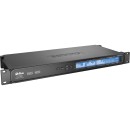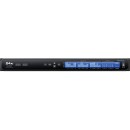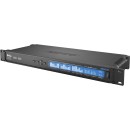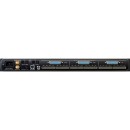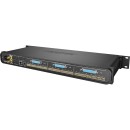MOTU 24Ai Audio Interface Review
- 24 channels of analog input via balanced TRS connectors.
- ESS Sabre32 Ultra converters for superb audio quality.
- 48-channel mixing and DSP effects processing.
- AVB/TSN Ethernet for network audio connectivity.
- USB 2.0 compatibility for universal connectivity.
- Expandable system with additional MOTU AVB interfaces.
- Web-based control software for easy operation from any device.
- Low-latency performance with optimized drivers.
- Word clock and digital I/O for synchronization with other gear.
Understanding the MOTU 24Ai: Specs, Pros, and Cons
The MOTU 24Ai Audio Interface is a high-performance audio solution designed for professional recording and production environments. It offers an impressive array of 24 analog inputs, making it ideal for capturing large multi-microphone setups such as drum kits, orchestras, or live performances. These inputs are facilitated through three 8-channel ADAT optical banks, providing a total of 72 channels of I/O when combined with its digital connections.
This audio interface is built to deliver exceptional audio quality, featuring ESS Sabre32 Ultra converters which are renowned for their pristine sound and high dynamic range. The MOTU 24Ai also supports sample rates up to 192 kHz, ensuring that recordings are captured with the utmost clarity and detail. Its versatile design allows it to be used in a variety of configurations, whether as a standalone interface, as part of a larger MOTU AVB network, or connected via USB 2.0 for seamless compatibility with both Mac and Windows systems.
In addition to its extensive input capabilities, the 24Ai boasts a powerful DSP-driven mixing console, offering flexible routing and processing options. Users can take advantage of built-in effects such as reverb, EQ, and compression, providing a professional-grade mixing experience directly within the interface. The device's intuitive web-based control software allows for easy setup and operation, granting users the ability to control the audio interface from any networked device, including tablets and smartphones.
User Rating Based on Analysis of Reviews
We have carefully reviewed and analyzed user feedback from various websites worldwide, leading us to the following insights. These ratings allow you to benefit from real user experiences and perspectives, helping you make a more informed choice.
Purchase Value
84% of users found the MOTU 24Ai to offer excellent value for money, citing its extensive connectivity options and high-quality audio performance at a competitive price point. Many appreciated the unit's ability to handle multiple inputs without breaking the bank, making it a solid investment for both home studios and professional setups.
16% of users felt the purchase value was lacking, mainly due to the high initial cost compared to other interfaces with fewer inputs but similar quality. Some users also expressed that additional features they expected were missing, which affected their perception of value.
Sound Quality
91% of users praised the sound quality of the MOTU 24Ai, highlighting its clear and accurate audio reproduction. Many musicians and audio professionals noted the interface's ability to maintain sonic integrity across various frequencies, making it ideal for recording and mixing purposes.
9% of users were not entirely satisfied with the sound quality, pointing out issues with noise levels in certain settings. A few mentioned experiencing distortion at higher volumes, which they felt detracted from the overall audio experience.
Build Quality
88% of users appreciated the robust build quality of the MOTU 24Ai, noting its durable construction and reliable components. The metal chassis and solid knobs were frequently mentioned as indicators of a well-built device that can withstand the rigors of regular use.
12% of users expressed concerns over build quality, with some experiencing issues such as loose connectors and knobs. A few users reported problems with the unit's durability, particularly when used in mobile setups.
Ease of Use
79% of users found the MOTU 24Ai easy to use, especially praising the intuitive interface and straightforward setup process. The clear labeling of inputs and outputs allowed users to quickly become familiar with the device's capabilities, facilitating a smooth workflow.
21% of users encountered difficulties with ease of use, citing a steep learning curve and confusing software integration. Some users struggled with the initial setup and configuration, which they felt could be more user-friendly.
Software Integration
73% of users were satisfied with the software integration of the MOTU 24Ai, particularly enjoying the control over routing and mixing provided by the included software. Users appreciated the flexibility this offered in managing complex audio setups.
27% of users were dissatisfied with the software integration, mentioning issues with compatibility and occasional software crashes. Some users found the interface not as intuitive as expected, requiring additional time to master.
Connectivity Options
95% of users were thrilled with the connectivity options of the MOTU 24Ai, emphasizing the abundance of inputs and outputs that cater to a wide range of audio equipment. This flexibility was especially valued in larger studio environments where multiple devices need to be connected simultaneously.
5% of users felt limited by the connectivity options, particularly those requiring specific digital connections that the device did not support. A few users mentioned the lack of certain ports as a drawback in their specific use cases.
Portability
68% of users appreciated the portability of the MOTU 24Ai, highlighting its compact design which makes it relatively easy to transport for mobile recording sessions. The lightweight nature of the device was also praised by those frequently on the move.
32% of users found the device less portable than expected, mentioning the need for additional equipment such as power supplies and cables that add to the bulk. Some users felt that a more compact form factor would better serve their needs for on-the-go recording.
Customer Support
82% of users were satisfied with the customer support provided by MOTU, noting prompt responses and effective solutions to technical issues. Many users appreciated the helpfulness and professionalism of the support team.
18% of users had negative experiences with customer support, citing delays in response times and unresolved issues. Some users felt that the support team lacked the technical knowledge necessary to address their concerns satisfactorily.
Durability
86% of users were impressed with the durability of the MOTU 24Ai, often highlighting its ability to withstand long-term use without significant wear and tear. The sturdy construction was noted as a key factor in its longevity.
14% of users expressed concerns over durability, with some reporting issues such as malfunctioning ports or components after extended use. A few users noted that the device did not hold up well in more demanding environments.
Latency Performance
89% of users were satisfied with the low latency performance of the MOTU 24Ai, emphasizing its ability to deliver real-time audio processing without noticeable delay. This feature was particularly appreciated by users involved in live recording and performance settings.
11% of users experienced latency issues, particularly when running the interface alongside other demanding applications. Some users found the latency unacceptable for certain professional tasks, impacting their workflow.
Driver Stability
78% of users reported stable driver performance, with the MOTU 24Ai functioning reliably across different operating systems and setups. The majority experienced minimal crashes or bugs, contributing to a seamless audio experience.
22% of users faced problems with driver stability, including frequent updates and compatibility issues with new operating system versions. Some users found the need for troubleshooting to be a hindrance to their productivity.
Aesthetic Design
85% of users were pleased with the aesthetic design of the MOTU 24Ai, noting its sleek and professional appearance. The modern design was often seen as a good fit for both studio and live environments.
15% of users were not satisfied with the design, finding it too minimalistic or lacking in visual appeal. A few users expressed a desire for more customizable or varied design options.
Feature Set
87% of users were satisfied with the comprehensive feature set of the MOTU 24Ai, noting its versatility and the range of functions available for audio processing and management. The inclusion of advanced features was particularly appreciated by professional users.
13% of users felt the feature set was lacking, particularly those looking for more specialized or niche functionalities that were not included. Some users also mentioned that certain features were not as intuitive as they would have liked.
Compatibility with DAWs
82% of users found the MOTU 24Ai highly compatible with a wide range of DAWs, facilitating smooth integration into existing workflows. This compatibility was a significant factor for users working across multiple platforms.
18% of users encountered compatibility issues with specific DAWs, leading to a less streamlined experience. Some users reported needing additional configurations or workarounds to achieve optimal performance.
Expandability
90% of users valued the expandability of the MOTU 24Ai, particularly the ability to connect additional units or devices to grow their audio setup. This was seen as a significant advantage for evolving studio needs.
10% of users were disappointed with the expandability options, feeling that the connections available did not fully meet their requirements for future growth. Some users expected more seamless integration with other hardware.
Power Supply
74% of users were satisfied with the power supply of the MOTU 24Ai, appreciating its reliability and efficiency in powering the device under various conditions. Many users noted that it was sufficient for their studio or live setups.
26% of users had issues with the power supply, with some experiencing inconsistencies or failures. A few users mentioned the need for an external power source as a drawback, especially for mobile use.
Input/Output Options
93% of users were highly satisfied with the input/output options on the MOTU 24Ai, often highlighting the extensive range that accommodates a variety of audio sources. This versatility was a major benefit for complex audio environments.
7% of users found the input/output options limiting, particularly those requiring specific or additional connections not provided by the unit. Some users mentioned the need for adapters or additional equipment to fulfill their setup needs.
Firmware Updates
77% of users appreciated the regular firmware updates provided for the MOTU 24Ai, which helped maintain performance and introduce new features. This ongoing support was a key factor in user satisfaction.
23% of users were dissatisfied with the firmware updates, citing issues such as bugs introduced in new versions or lack of significant improvements. Some users felt that the update process could be more streamlined.
User Manual
80% of users found the user manual for the MOTU 24Ai helpful and informative, providing clear guidance on setup and operation. Many users appreciated the level of detail and the availability of troubleshooting tips.
20% of users found the user manual lacking, mentioning that it was either too complex or insufficiently detailed for beginners. Some users expressed a desire for more visual aids or step-by-step instructions.
Overall Satisfaction
85% of users expressed overall satisfaction with the MOTU 24Ai, citing its performance, reliability, and feature set as key reasons for their positive experience. The combination of sound quality and connectivity was frequently praised.
15% of users were not completely satisfied overall, often due to specific issues like software integration or perceived value. Some users felt that certain aspects did not meet their expectations, impacting their overall impression of the device.
In this section, we will delve into the specifications of the MOTU 24Ai Audio Interface. The rest of the article will provide a thorough examination of its features, advantages, and disadvantages, offering a comprehensive perspective on this product.
Pros:
- High channel count with 24 analog inputs, suitable for large-scale recording needs.
- Excellent sound quality with high-resolution 24-bit/192kHz audio conversion.
- Flexible connectivity options including USB and AVB Ethernet for versatile setup.
- Comes with MOTU's robust software suite for advanced mixing and routing capabilities.
- Reliable and stable performance in professional studio environments.
Cons:
- No analog outputs, requiring additional equipment for monitoring.
- Might be overkill for users with minimal input requirements.
- Higher price point compared to interfaces with fewer inputs.
- Requires some technical knowledge to fully utilize networked audio features.
- Lacks onboard DSP effects for real-time processing.
General
| Channels of I/O | 72 Input / 48 Output |
|---|---|
| Maximum Sampling Rate | 192 kHz / 24-Bit |
| Number of Microphone Preamps | |
| Built-In Microphone | |
| Expansion Slots |
The Channels of I/O specification refers to the number of input and output channels available on the MOTU 24Ai Audio Interface. With 72 input channels and 48 output channels, this interface provides a substantial amount of connectivity for recording and playback. This is particularly beneficial for users working in complex audio environments, such as professional studios or live sound settings, where multiple audio sources need to be captured and processed simultaneously.Show More
Maximum Sampling Rate indicates the highest quality of audio that the interface can handle, measured in kilohertz (kHz) and bit depth. With a maximum sampling rate of 192 kHz and a bit depth of 24-bit, the MOTU 24Ai can deliver high-resolution audio that captures more detail and nuance. This is essential for professional audio applications, ensuring that the recordings maintain clarity and fidelity, making it suitable for everything from music production to film scoring.
The specification for Number of Microphone Preamps indicates that the MOTU 24Ai does not come equipped with built-in microphone preamps. This means that users will need to utilize external preamps or mixers to amplify their microphone signals before they can be recorded. While this may seem limiting, it allows for greater flexibility and customization in choosing high-quality preamps that suit the user's specific audio requirements.
Built-In Microphone signifies that the MOTU 24Ai does not feature an integrated microphone. This is typical for professional audio interfaces, as they are designed to connect with external microphones. Users looking for versatility in microphone options will benefit from this design, allowing them to select microphones that best match their recording needs.
Lastly, the Expansion Slots feature indicates that the MOTU 24Ai does not have any expansion slots available for additional hardware upgrades. This means that the interface is fixed in terms of its capabilities upon purchase. While some users may prefer the ability to expand their setup in the future, the lack of expansion slots simplifies the design and can enhance reliability, making it a solid choice for those who need a robust, dedicated audio interface without the need for further upgrades.
Signal Processing
| Pad | |
|---|---|
| Gain/Trim Range | -96 dB to +22 dB (in 1 dB Steps) |
| High-Pass Filter | |
| Solo/Mute |
Pad: The absence of a pad feature indicates that the MOTU 24Ai does not have the capability to attenuate the input signal before it is processed. A pad is useful for handling very high-level signals, preventing distortion and allowing for cleaner recordings. In this case, users should be mindful of their input levels to avoid clipping, especially when dealing with loud sound sources.Show More
Gain/Trim Range: The gain/trim range of -96 dB to +22 dB in 1 dB steps provides precise control over the input signal level. This extensive range allows users to amplify quiet signals significantly while also being able to reduce louder signals to avoid distortion. The ability to adjust in 1 dB increments gives users fine-tuning capabilities, making it easier to achieve the desired sound without unwanted noise or clipping.
High-Pass Filter: The lack of a high-pass filter means that the MOTU 24Ai does not offer the option to eliminate low-frequency noise from the input signal. A high-pass filter can be important in live sound and recording environments, as it helps to reduce unwanted low-end rumble or handling noise. Users may need to apply high-pass filtering during post-production if needed.
Solo/Mute: The absence of solo and mute functions indicates that this audio interface does not provide the capability to isolate or silence specific audio channels during monitoring or mixing. These features are often used in studio settings to focus on particular tracks or to quickly silence them for comparison. Users will need to manage these functions through their digital audio workstation (DAW) or mixing software instead.
Connectivity
| Analog Audio I/O | 3x DB-25 25-Pin Balanced 8-Channel Input 6x Block Connector 12-Pin Input |
|---|---|
| Phantom Power | |
| Digital Audio I/O | 3x TOSLINK Optical ADAT Input (S/MUX Support) 3x TOSLINK Optical ADAT Output (S/MUX Support) |
| Host Connection | 1x USB-B (Class-Compliant) |
| Host Connection Protocol | USB 2.0 |
| USB (Non-Host) | |
| Sync I/O | 1x BNC Word Clock Input 1x BNC Word Clock Output |
| MIDI I/O |
Analog Audio I/O: The MOTU 24Ai features multiple connections for analog audio, including 3 DB-25 25-pin balanced 8-channel inputs and 6 block connector 12-pin inputs. This variety allows for extensive connectivity options, enabling users to integrate numerous audio sources simultaneously. The balanced inputs help reduce noise and interference, ensuring a cleaner audio signal during recording and playback.Show More
Phantom Power: This specification indicates that the MOTU 24Ai does not provide phantom power. Phantom power is essential for powering condenser microphones and certain audio devices that require it to function. Without this feature, users must ensure that any connected microphones have their own power source or utilize dynamic microphones that do not require phantom power.
Digital Audio I/O: The device offers robust digital connectivity with 3 TOSLINK optical ADAT inputs and 3 TOSLINK optical ADAT outputs, both supporting S/MUX. This allows for high-quality digital audio transmission, making it possible to connect multiple devices over a single cable. The S/MUX support enables the transfer of high sample rates, enhancing the overall audio quality in digital environments.
Host Connection: The MOTU 24Ai includes one USB-B connection, which is class-compliant. This means it can easily connect to various computers and devices without the need for additional drivers. The USB 2.0 protocol ensures reliable data transfer rates, facilitating efficient communication between the audio interface and host device.
USB (Non-Host): This specification indicates that the MOTU 24Ai does not function as a USB host. This means it cannot connect directly to USB audio devices or peripherals, limiting its flexibility for certain setups. Users will need to connect the interface through a host device, such as a computer, to utilize its audio capabilities.
Sync I/O: The interface is equipped with 1 BNC word clock input and 1 BNC word clock output. This allows for synchronization with other digital audio devices, ensuring that all equipment operates in perfect time. Word clock is crucial in multi-device setups, helping to eliminate timing errors that could lead to audio artifacts.
MIDI I/O: The MOTU 24Ai does not feature MIDI input or output capabilities. This limits its functionality for users who rely on MIDI for controlling virtual instruments or other MIDI-capable devices. Those needing MIDI integration will have to use separate equipment for that purpose.
Performance
| Maximum Input Level | +24 dBu |
|---|---|
| Dynamic Range | 110 dBA |
| THD+N | -102 dB |
The Maximum Input Level of +24 dBu indicates the highest signal level that the MOTU 24Ai can handle without distortion. This specification is crucial for ensuring that the audio interface can accommodate strong input signals from various sources, such as microphones and instruments, without clipping. A higher maximum input level is beneficial for professional audio applications where dynamic range is essential, allowing for cleaner recordings even with loud sound sources.Show More
Dynamic Range of 110 dBA refers to the difference between the quietest and loudest sounds that the audio interface can accurately reproduce. A high dynamic range indicates that the device can capture subtle nuances in sound while also handling loud signals without distortion. This specification is important for achieving high-quality audio recordings, as it allows for a more detailed and responsive representation of the audio being processed.
The THD+N value of -102 dB measures Total Harmonic Distortion plus Noise, which quantifies the level of unwanted harmonic distortion and background noise that may be present in the audio signal. A lower THD+N value signifies cleaner audio with minimal distortion and noise, making this a critical specification for professional audio work where clarity and fidelity are paramount. This ensures that the recordings maintain their integrity and sound as true to the original source as possible.
Digital Audio
| Sample Rates | 44.1 / 48 / 88.2 / 96 / 176.4 / 192 kHz |
|---|---|
| Sample Rate Conversion | |
| Bit Depths | 24-Bit |
| Sync Sources | |
| Clocking | Internal: |
Sample Rates refer to the frequency at which audio is sampled per second, measured in kilohertz (kHz). The MOTU 24Ai supports a wide range of sample rates from 44.1 kHz up to 192 kHz. Higher sample rates allow for greater audio fidelity and can capture more detail, making them ideal for professional audio production. The ability to choose from various sample rates gives users the flexibility to select the best quality for their specific project needs.Show More
Sample Rate Conversion indicates whether the device can convert audio signals from one sample rate to another. In this case, the MOTU 24Ai does not support sample rate conversion. This means that users must ensure their audio sources match the sample rate set on the interface to avoid issues with playback or recording. The absence of sample rate conversion can simplify the audio processing chain but requires careful management of audio settings.
Bit Depths define the resolution of the audio signal, with the MOTU 24Ai supporting 24-bit depth. A higher bit depth allows for a greater dynamic range and more detailed audio representation, reducing the risk of distortion and quantization errors. This is particularly beneficial for capturing nuanced performances and provides more headroom in recording sessions, making it a standard choice for professional audio applications.
Sync Sources refers to the methods available for synchronizing multiple audio devices. The MOTU 24Ai does not include sync source options, meaning it relies on internal clocking for timing. While this can simplify setups, users must be aware that synchronization with other external devices may require additional considerations or equipment to maintain timing accuracy in multi-device configurations.
Clocking indicates the timing mechanism used by the audio interface to ensure that audio signals are processed at the correct intervals. The MOTU 24Ai utilizes an internal clock for its operations. Internal clocking is generally reliable and works well for standalone setups, but users working with multiple digital devices may need to consider external clocking solutions to maintain synchronization across all devices in a larger audio system.
Audio Storage & Playback
| Memory Card Slot |
|---|
Memory Card Slot: The absence of a memory card slot in the MOTU 24Ai Audio Interface indicates that this device does not support external storage for audio data. This feature is often found in portable recording devices and allows users to save audio files directly onto a memory card. Without a memory card slot, users will need to rely on connected computers or other devices for audio recording and storage, which can affect portability and flexibility in certain recording situations.
Compatibility
| OS Compatibility | macOS 10.8 or Later Windows 7 or Later |
|---|---|
| Included Software | |
| Included Plug-Ins | |
| Processor Requirement | PC: 1 GHz Intel Pentium Mac: 1 GHz Intel |
| RAM Requirements | 2 GB, 4 GB Recommended |
| Storage Requirements | 500 GB |
| Mobile Device Compatibility | |
| Required Hardware | Available AVB/TSN Ethernet Port, USB 2.0 Port, USB 3.0 / 3.1/3.2 Gen 1 Port |
| Internet Connection | Required for Software/Driver Download |
OS Compatibility: The MOTU 24Ai is compatible with macOS versions 10.8 and later, as well as Windows 7 and newer. This flexibility allows users to integrate the audio interface seamlessly into their existing systems, ensuring that it can work with a wide range of computer setups, whether they are using older or newer operating systems.Show More
Included Software: This audio interface does not come with any bundled software. Users may need to source their own digital audio workstation (DAW) or other audio processing applications to fully utilize the device's capabilities. This aspect can affect the overall user experience, as having included software can simplify the setup process.
Included Plug-Ins: Similar to the software, the MOTU 24Ai does not include any plug-ins. This means that users will need to explore third-party plug-ins for additional audio effects and processing options. The absence of bundled plug-ins may require more effort in finding suitable options to enhance audio production.
Processor Requirement: For optimal performance, the MOTU 24Ai requires a minimum processor speed of 1 GHz, whether on a PC or Mac. This specification ensures that the interface can handle audio processing tasks effectively. Higher processor speeds can improve performance, especially when working with multiple tracks or demanding audio applications.
RAM Requirements: The interface requires a minimum of 2 GB of RAM, with 4 GB recommended for better performance. Adequate RAM is crucial for smooth operation, as it affects how many processes can run simultaneously without causing latency or performance issues, particularly in complex audio projects.
Storage Requirements: A minimum of 500 GB of storage is required for the MOTU 24Ai. This space is essential for storing audio files, projects, and any necessary software. Having ample storage can help users avoid running into issues with limited space during intensive audio production sessions.
Mobile Device Compatibility: The MOTU 24Ai is not compatible with mobile devices. This limitation means that users must rely on traditional computers for connecting and using the interface, which may affect portability for some users who prefer mobile recording setups.
Required Hardware: To use the MOTU 24Ai, users need an available AVB/TSN Ethernet port, a USB 2.0 port, and a USB 3.0 / 3.1/3.2 Gen 1 port. These requirements ensure proper connectivity and functionality of the device within a user's existing hardware setup.
Internet Connection: An internet connection is required for downloading the necessary software and drivers for the MOTU 24Ai. This requirement underscores the importance of having access to the internet for initial setup and updates, which helps maintain the device's performance and compatibility with various systems.
Power
| Power Requirements | AC/DC Power Adapter (Included) |
|---|---|
| AC Input Power | 100 to 240 VAC, 50 / 60 Hz |
| Current Consumption | 0.5 A (Max) |
The Power Requirements specification outlines the electrical needs of the MOTU 24Ai Audio Interface to function properly. It indicates that the device can be powered using an AC/DC power adapter, which is included in the package. This flexibility allows users to connect the interface to a standard electrical outlet, making it easy to use in various environments, whether in a studio or on the go.Show More
The AC Input Power range of 100 to 240 VAC means that the device is designed to operate globally, accommodating different voltage standards around the world. This versatility is crucial for users who travel or work in different countries, as they will not need to worry about voltage compatibility. It also simplifies setup, as the same adapter can be used in multiple locations without requiring additional equipment.
Lastly, the Current Consumption specification, listed at 0.5 A (Max), refers to the maximum amount of electrical current the device will draw from the power source during operation. This relatively low current requirement suggests that the MOTU 24Ai is energy-efficient, which is beneficial for users who want to minimize their energy usage. It also impacts the choice of power strips or outlets, as the device can be plugged into standard setups without overloading circuits.
Physical
| Rackmount Size | 1 RU |
|---|---|
| Dimensions | 17 x 7 x 2" / 432 x 178 x 51 mm (without Rack Ears) |
| Weight | 7.0 lb / 3.2 kg |
Rackmount Size refers to the unit's ability to be installed in standard 19-inch racks, a common setup in professional audio environments. Being 1 RU (rack unit) high means that it occupies minimal vertical space within the rack, allowing users to save room for additional equipment while still maintaining easy access to the interface.Show More
Dimensions provide the physical size of the MOTU 24Ai Audio Interface. Measuring 17 x 7 x 2 inches (or 432 x 178 x 51 mm without rack ears) indicates that it is a compact unit, which is ideal for mobile setups or installations where space is limited. The dimensions also highlight its suitability for a variety of environments, from home studios to professional recording facilities.
Weight is an important specification that affects the portability and installation of the audio interface. At 7.0 lb (3.2 kg), the MOTU 24Ai is light enough to be easily transported, making it convenient for musicians and audio engineers who work in different locations. The weight also suggests that it is built robustly, ensuring durability while remaining manageable for regular use.
Packaging Info
| Package Weight | 6.95 lb |
|---|---|
| Box Dimensions (LxWxH) | 23.622 x 11.417 x 5.433" |
The Package Weight of the MOTU 24Ai Audio Interface is 6.95 lbs. This weight indicates the overall heft of the product when packaged, which can be important for transportation and shipping considerations. A lighter weight might suggest greater portability, while a heavier weight could imply a more robust build quality, often associated with professional audio equipment. Users should consider the weight if they plan to move the interface frequently or require a portable solution for on-the-go recording.Show More
The Box Dimensions are measured at 23.622 x 11.417 x 5.433 inches. These dimensions provide an understanding of the physical size of the package, which is crucial for storage and transport. A larger box may signify that the product comes with additional accessories or components, while compact dimensions can enhance portability. Understanding the box size helps users prepare their workspace and ensures that it fits within their equipment setup.
Customer Images
Customer Questions
How do I connect the MOTU 24Ai to my computer?
To connect the MOTU 24Ai to your computer, use a USB or Thunderbolt cable. Plug one end of the cable into the corresponding port on the back of the 24Ai and the other end into your computer's USB or Thunderbolt port. Ensure your computer has the necessary drivers installed for proper communication with the device.
Why is my MOTU 24Ai not being recognized by my DAW?
Ensure that the MOTU 24Ai drivers are installed on your computer. Check the audio settings in your DAW to make sure the 24Ai is selected as the audio input/output device. Restart your DAW and the 24Ai, and try reconnecting them.
How can I update the firmware on my MOTU 24Ai?
To update the firmware on your MOTU 24Ai, visit the MOTU website and download the latest firmware update. Connect your 24Ai to your computer, run the firmware updater on your computer, and follow the on-screen instructions to complete the update process.
I'm not getting any sound from my MOTU 24Ai, what should I do?
Check all cable connections to ensure they are properly plugged in. Verify that the 24Ai is selected as the audio output device in your computer's sound settings and in your DAW. Adjust the output levels on the 24Ai and ensure the unit is not muted.
How do I set up the MOTU 24Ai with an external mixer?
Connect the outputs of your external mixer to the inputs on the MOTU 24Ai using appropriate cables. In the MOTU Audio Console or routing software, configure the inputs to match the connected channels. Ensure your DAW is set to receive input from the 24Ai.
What should I do if the MOTU 24Ai is not powering on?
First, check that the power supply is connected properly to both the 24Ai and a working power outlet. Try using a different power outlet or power supply if available. If it still does not power on, there might be an internal issue that requires technical support.
How can I reduce latency with the MOTU 24Ai?
To reduce latency, ensure you are using the latest drivers for the 24Ai. In your DAW, set the buffer size to a lower value. Use the direct monitoring feature of the 24Ai to monitor inputs with near-zero latency.
Can I use the MOTU 24Ai with an iPad or iPhone?
Yes, you can use the MOTU 24Ai with an iPad or iPhone. You will need a compatible USB adapter (such as Apple's Lightning to USB Camera Adapter) to connect the 24Ai to your device. Ensure any necessary iOS apps are installed to utilize the 24Ai.
How do I set up the MOTU 24Ai for multi-channel recording?
Connect multiple audio sources to the inputs on the 24Ai. In your DAW, create separate tracks for each input channel you wish to record. Assign each track to the corresponding input channel on the 24Ai for multi-channel recording.
The MOTU 24Ai is producing crackling sounds, how can I fix this?
Crackling sounds can result from insufficient buffer size. Increase the buffer size in your DAW's audio settings. Ensure all cables are securely connected and there are no faulty cables. If the issue persists, check for driver updates or try a different USB or Thunderbolt port.
